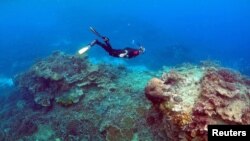Scientists have discovered a colorful “underwater garden” at depths of up to 2 kilometers during a recent research voyage south of Tasmania in Australia.
The researchers used special cameras to probe 45 undersea mountains, finding more than 100 unnamed species of corals, lobsters and mollusks. The expedition also discovered bioluminescent squids, deep-water sharks and basketwork eels.
Experts spent a month onboard the research vessel Investigator, which is operated by the Commonwealth Scientific and Industrial Research Organization, or the CSIRO. It is an independent Australian government agency responsible for scientific research.
Scientists have been exploring the Tasmanian cluster of ridges known as seamounts in Australia’s Tasman Fracture and Huon marine parks.
The coral they found is soft, which means it is different from the coral in a tropical reef.
The expedition’s chief scientist is Alan Williams from the CSIRO.
“Quite amazingly at these kinds of depths there are coral reefs that in many ways look similar to the kinds of reefs you see in shallow tropical areas, and so what we were seeing on our screens delivered in real time from the cameras were just absolutely fantastic images of these extensive, delicate, colorful and very rich coral reef systems,” he said.
The research teams also saw images of the lasting damage inflicted on the ocean-floor by fishing crews. Trawl fishing was banned in the 1990s but much of the region’s coral is still to fully recover.
Experts say science knows more about the surface of the moon than it does about the deep sea. Despite their research south of Tasmania, they still do not understand why bright corals can survive in a pitch-black world far beneath the surface of the ocean.
